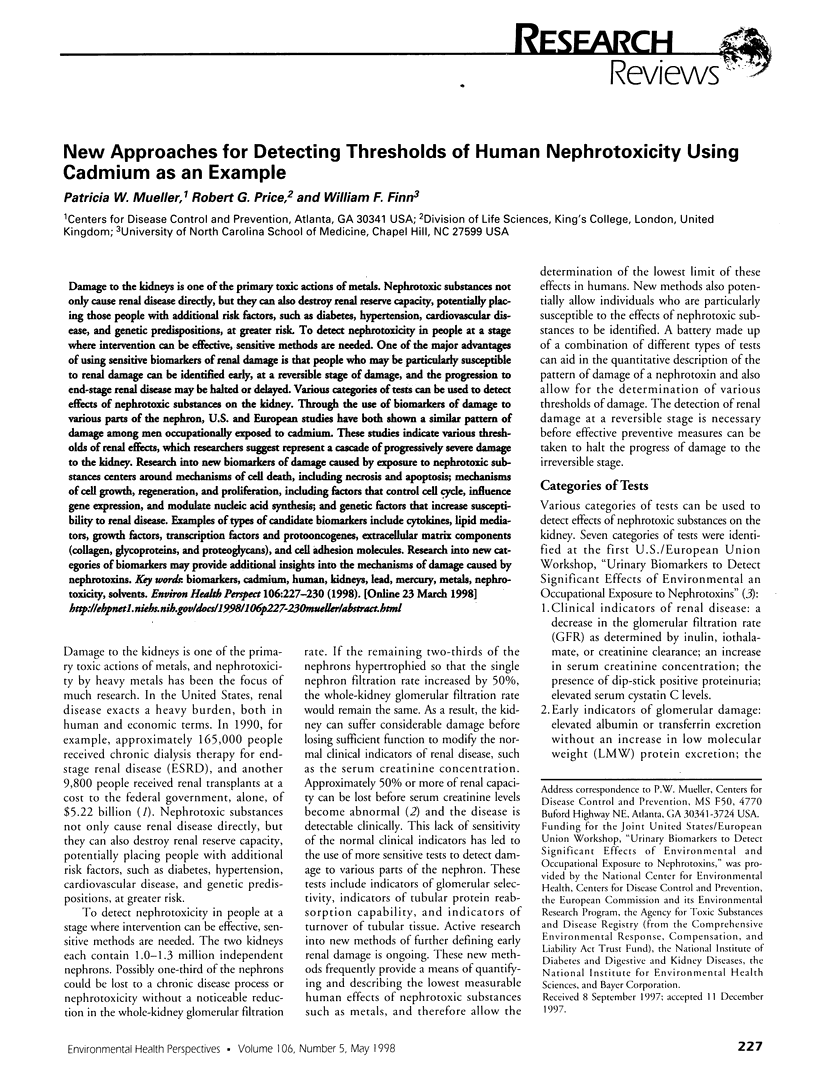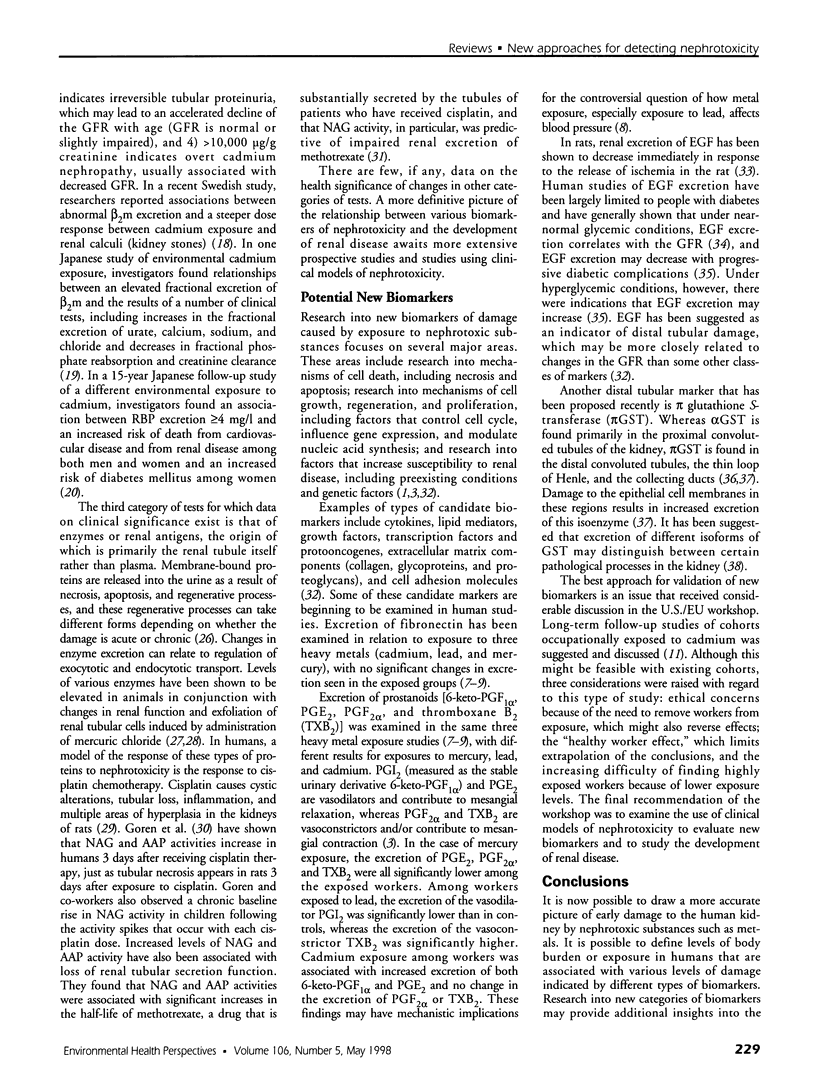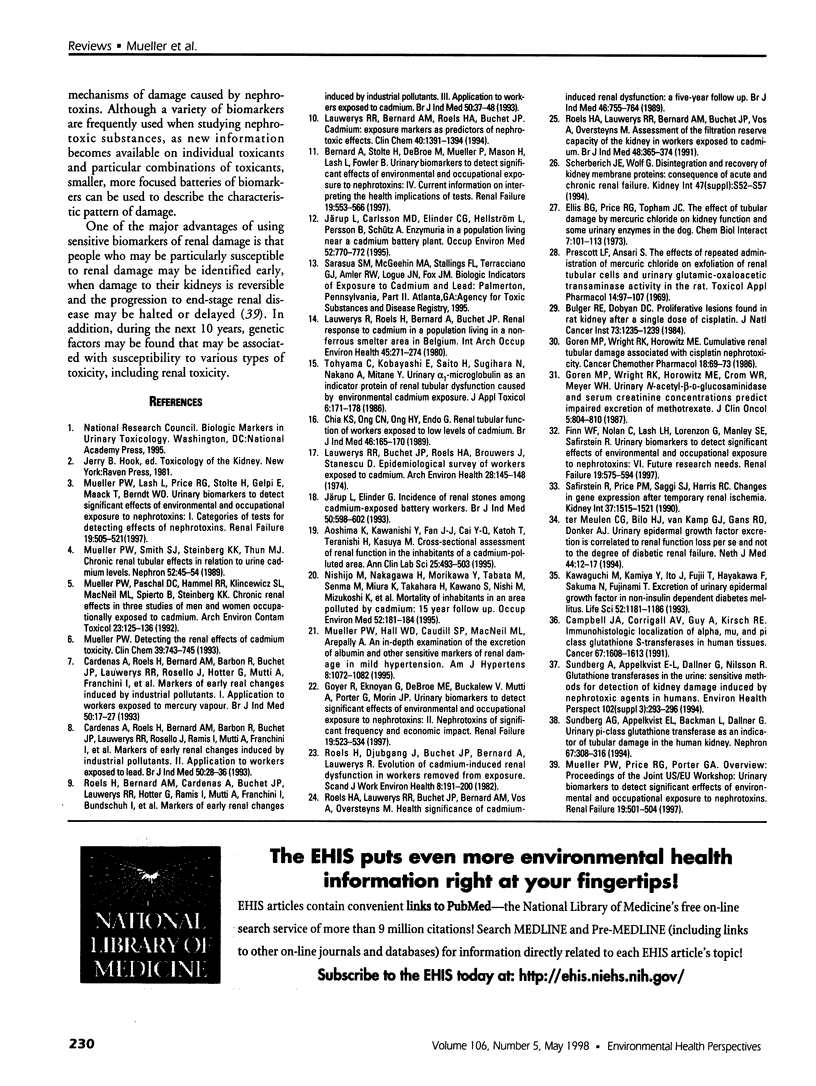Abstract
Damage to the kidneys is one of the primary toxic actions of metals. Nephrotoxic substances not only cause renal disease directly, but they can also destroy renal reserve capacity, potentially placing those people with additional risk factors, such as diabetes, hypertension, cardiovascular disease, and genetic predispositions, at greater risk. To detect nephrotoxicity in people at a stage where intervention can be effective, sensitive methods are needed. One of the major advantages of using sensitive biomarkers of renal damage is that people who may be particularly susceptible to renal damage can be identified early, at a reversible stage of damage, and the progression to end-stage renal disease may be halted or delayed. Various categories of tests can be used to detect effects of nephrotoxic substances on the kidney. Through the use of biomarkers of damage to various parts of the nephron, U.S. and European studies have both shown a similar pattern of damage among men occupationally exposed to cadmium. These studies indicate various thresholds of renal effects, which researchers suggest represent a cascade of progressively severe damage to the kidney. Research into new biomarkers of damage caused by exposure to nephrotoxic substances centers around mechanisms of cell death, including necrosis and apoptosis; mechanisms of cell growth, regeneration, and proliferation, including factors that control cell cycle, influence gene expression, and modulate nucleic acid synthesis; and genetic factors that increase susceptibility to renal disease. Examples of types of candidate biomarkers include cytokines, lipid mediators, growth factors, transcription factors and protooncogenes, extracellular matrix components (collagen, glycoproteins, and proteoglycans), and cell adhesion molecules. Research into new categories of biomarkers may provide additional insights into the mechanisms of damage caused by nephrotoxins.
Full text
PDF



Selected References
These references are in PubMed. This may not be the complete list of references from this article.
- Aoshima K., Kawanishi Y., Fan J. J., Cai Y. Q., Katoh T., Teranishi H., Kasuya M. Cross-sectional assessment of renal function in the inhabitants of a cadmium-polluted area. Ann Clin Lab Sci. 1995 Nov-Dec;25(6):493–503. [PubMed] [Google Scholar]
- Bernard A., Stolte H., De Broe M. E., Mueller P. W., Mason H., Lash L. H., Fowler B. A. Urinary biomarkers to detect significant effects of environmental and occupational exposure to nephrotoxins. IV. Current information on interpreting the health implications of tests. Ren Fail. 1997 Jul;19(4):553–566. doi: 10.3109/08860229709048691. [DOI] [PubMed] [Google Scholar]
- Bulger R. E., Dobyan D. C. Proliferative lesions found in rat kidneys after a single dose of cisplatin. J Natl Cancer Inst. 1984 Nov;73(5):1235–1242. [PubMed] [Google Scholar]
- Campbell J. A., Corrigall A. V., Guy A., Kirsch R. E. Immunohistologic localization of alpha, mu, and pi class glutathione S-transferases in human tissues. Cancer. 1991 Mar 15;67(6):1608–1613. doi: 10.1002/1097-0142(19910315)67:6<1608::aid-cncr2820670623>3.0.co;2-s. [DOI] [PubMed] [Google Scholar]
- Chia K. S., Ong C. N., Ong H. Y., Endo G. Renal tubular function of workers exposed to low levels of cadmium. Br J Ind Med. 1989 Mar;46(3):165–170. doi: 10.1136/oem.46.3.165. [DOI] [PMC free article] [PubMed] [Google Scholar]
- Cárdenas A., Roels H., Bernard A. M., Barbon R., Buchet J. P., Lauwerys R. R., Roselló J., Hotter G., Mutti A., Franchini I. Markers of early renal changes induced by industrial pollutants. I. Application to workers exposed to mercury vapour. Br J Ind Med. 1993 Jan;50(1):17–27. doi: 10.1136/oem.50.1.17. [DOI] [PMC free article] [PubMed] [Google Scholar]
- Cárdenas A., Roels H., Bernard A. M., Barbon R., Buchet J. P., Lauwerys R. R., Roselló J., Ramis I., Mutti A., Franchini I. Markers of early renal changes induced by industrial pollutants. II. Application to workers exposed to lead. Br J Ind Med. 1993 Jan;50(1):28–36. doi: 10.1136/oem.50.1.28. [DOI] [PMC free article] [PubMed] [Google Scholar]
- Ellis B. G., Price R. G., Topham J. C. The effect of tubular damage by mercuric chloride on kidney function and some urinary enzymes in the dog. Chem Biol Interact. 1973 Aug;7(2):101–113. doi: 10.1016/0009-2797(73)90019-7. [DOI] [PubMed] [Google Scholar]
- Finn W. F., Nolan C., Lash L. H., Lorenzon G., Manley S. E., Safirstein R. Urinary biomarkers to detect significant effects of environmental and occupational exposure to nephrotoxins. VI. Future research needs. Ren Fail. 1997 Jul;19(4):575–594. doi: 10.3109/08860229709048693. [DOI] [PubMed] [Google Scholar]
- Goren M. P., Wright R. K., Horowitz M. E., Crom W. R., Meyer W. H. Urinary N-acetyl-beta-D-glucosaminidase and serum creatinine concentrations predict impaired excretion of methotrexate. J Clin Oncol. 1987 May;5(5):804–810. doi: 10.1200/JCO.1987.5.5.804. [DOI] [PubMed] [Google Scholar]
- Goren M. P., Wright R. K., Horowitz M. E. Cumulative renal tubular damage associated with cisplatin nephrotoxicity. Cancer Chemother Pharmacol. 1986;18(1):69–73. doi: 10.1007/BF00253068. [DOI] [PubMed] [Google Scholar]
- Goyer R., Eknoyan G., De Broe M. E., Buckalew V. M., Mutti A., Porter G. A., Morin J. P. Urinary biomarkers to detect significant effects of environmental and occupational exposure to nephrotoxins. II. Nephrotoxins of significant frequency and economic impact. Ren Fail. 1997 Jul;19(4):523–534. doi: 10.3109/08860229709048689. [DOI] [PubMed] [Google Scholar]
- Järup L., Carlsson M. D., Elinder C. G., Hellström L., Persson B., Schütz A. Enzymuria in a population living near a cadmium battery plant. Occup Environ Med. 1995 Nov;52(11):770–772. doi: 10.1136/oem.52.11.770. [DOI] [PMC free article] [PubMed] [Google Scholar]
- Järup L., Elinder C. G. Incidence of renal stones among cadmium exposed battery workers. Br J Ind Med. 1993 Jul;50(7):598–602. doi: 10.1136/oem.50.7.598. [DOI] [PMC free article] [PubMed] [Google Scholar]
- Kawaguchi M., Kamiya Y., Ito J., Fujii T., Hayakawa F., Sakuma N., Fujinami T. Excretion of urinary epidermal growth factor in non-insulin dependent diabetes mellitus. Life Sci. 1993;52(14):1181–1186. doi: 10.1016/0024-3205(93)90100-h. [DOI] [PubMed] [Google Scholar]
- Lauwerys R. R., Bernard A. M., Roels H. A., Buchet J. P. Cadmium: exposure markers as predictors of nephrotoxic effects. Clin Chem. 1994 Jul;40(7 Pt 2):1391–1394. [PubMed] [Google Scholar]
- Lauwerys R. R., Buchet J. P., Roels H. A., Brouwers J., Stanescu D. Epidemiological survey of workers exposed to cadmium. Arch Environ Health. 1974 Mar;28(3):145–148. doi: 10.1080/00039896.1974.10666455. [DOI] [PubMed] [Google Scholar]
- Lauwerys R., Roels H., Bernard A., Buchet J. P. Renal response to cadmium in a population living in a nonferrous smelter area in Belgium. Int Arch Occup Environ Health. 1980;45(3):271–274. doi: 10.1007/BF00380790. [DOI] [PubMed] [Google Scholar]
- Mueller P. W. Detecting the renal effects of cadmium toxicity. Clin Chem. 1993 May;39(5):743–745. [PubMed] [Google Scholar]
- Mueller P. W., Hall W. D., Caudill S. P., MacNeil M. L., Arepally A. An in-depth examination of the excretion of albumin and other sensitive markers of renal damage in mild hypertension. Am J Hypertens. 1995 Nov;8(11):1072–1082. doi: 10.1016/0895-7061(95)00231-d. [DOI] [PubMed] [Google Scholar]
- Mueller P. W., Lash L. H., Price R. G., Stolte H., Gelpi E., Maack T., Berndt W. O. Urinary biomarkers to detect significant effects of environmental and occupational exposure to nephrotoxins. I. Categories of tests for detecting effects of nephrotoxins. Ren Fail. 1997 Jul;19(4):505–521. doi: 10.3109/08860229709048688. [DOI] [PubMed] [Google Scholar]
- Mueller P. W., Paschal D. C., Hammel R. R., Klincewicz S. L., MacNeil M. L., Spierto B., Steinberg K. K. Chronic renal effects in three studies of men and women occupationally exposed to cadmium. Arch Environ Contam Toxicol. 1992 Jul;23(1):125–136. doi: 10.1007/BF00226005. [DOI] [PubMed] [Google Scholar]
- Mueller P. W., Price R. G., Porter G. A. Proceedings of the Joint US/EU Workshop: urinary biomarkers to detect significant effects of environmental and occupational exposure to nephrotoxins. Ren Fail. 1997 Jul;19(4):501–504. doi: 10.3109/08860229709048687. [DOI] [PubMed] [Google Scholar]
- Mueller P. W., Smith S. J., Steinberg K. K., Thun M. J. Chronic renal tubular effects in relation to urine cadmium levels. Nephron. 1989;52(1):45–54. doi: 10.1159/000185581. [DOI] [PubMed] [Google Scholar]
- Nishijo M., Nakagawa H., Morikawa Y., Tabata M., Senma M., Miura K., Takahara H., Kawano S., Nishi M., Mizukoshi K. Mortality of inhabitants in an area polluted by cadmium: 15 year follow up. Occup Environ Med. 1995 Mar;52(3):181–184. doi: 10.1136/oem.52.3.181. [DOI] [PMC free article] [PubMed] [Google Scholar]
- Prescott L. F., Ansari S. The effects of repeated administration of mercuric chloride on exfoliation of renal tubular cells and urinary glutamic-oxaloacetic transaminase activity in the rat. Toxicol Appl Pharmacol. 1969 Jan;14(1):97–107. doi: 10.1016/0041-008x(69)90169-0. [DOI] [PubMed] [Google Scholar]
- Roels H. A., Lauwerys R. R., Bernard A. M., Buchet J. P., Vos A., Oversteyns M. Assessment of the filtration reserve capacity of the kidney in workers exposed to cadmium. Br J Ind Med. 1991 Jun;48(6):365–374. doi: 10.1136/oem.48.6.365. [DOI] [PMC free article] [PubMed] [Google Scholar]
- Roels H. A., Lauwerys R. R., Buchet J. P., Bernard A. M., Vos A., Oversteyns M. Health significance of cadmium induced renal dysfunction: a five year follow up. Br J Ind Med. 1989 Nov;46(11):755–764. doi: 10.1136/oem.46.11.755. [DOI] [PMC free article] [PubMed] [Google Scholar]
- Roels H., Bernard A. M., Cárdenas A., Buchet J. P., Lauwerys R. R., Hotter G., Ramis I., Mutti A., Franchini I., Bundschuh I. Markers of early renal changes induced by industrial pollutants. III. Application to workers exposed to cadmium. Br J Ind Med. 1993 Jan;50(1):37–48. doi: 10.1136/oem.50.1.37. [DOI] [PMC free article] [PubMed] [Google Scholar]
- Roels H., Djubgang J., Buchet J. P., Bernard A., Lauwerys R. Evolution of cadmium-induced renal dysfunction in workers removed from exposure. Scand J Work Environ Health. 1982 Sep;8(3):191–200. doi: 10.5271/sjweh.2476. [DOI] [PubMed] [Google Scholar]
- Scherberich J. E., Wolf G. Disintegration and recovery of kidney membrane proteins: consequence of acute and chronic renal failure. Kidney Int Suppl. 1994 Nov;47:S52–S57. [PubMed] [Google Scholar]
- Sundberg A. G., Appelkvist E. L., Bäckman L., Dallner G. Urinary pi-class glutathione transferase as an indicator of tubular damage in the human kidney. Nephron. 1994;67(3):308–316. doi: 10.1159/000187985. [DOI] [PubMed] [Google Scholar]
- Sundberg A., Appelkvist E. L., Dallner G., Nilsson R. Glutathione transferases in the urine: sensitive methods for detection of kidney damage induced by nephrotoxic agents in humans. Environ Health Perspect. 1994 Sep;102 (Suppl 3):293–296. doi: 10.1289/ehp.94102s3293. [DOI] [PMC free article] [PubMed] [Google Scholar]
- Tohyama C., Kobayashi E., Saito H., Sugihara N., Nakano A., Mitane Y. Urinary alpha 1-microglobulin as an indicator protein of renal tubular dysfunction caused by environmental cadmium exposure. J Appl Toxicol. 1986 Jun;6(3):171–178. doi: 10.1002/jat.2550060307. [DOI] [PubMed] [Google Scholar]
- ter Meulen C. G., Bilo H. J., van Kamp G. J., Gans R. O., Donker A. J. Urinary epidermal growth factor excretion is correlated to renal function loss per se and not to the degree of diabetic renal failure. Neth J Med. 1994 Jan;44(1):12–17. [PubMed] [Google Scholar]


